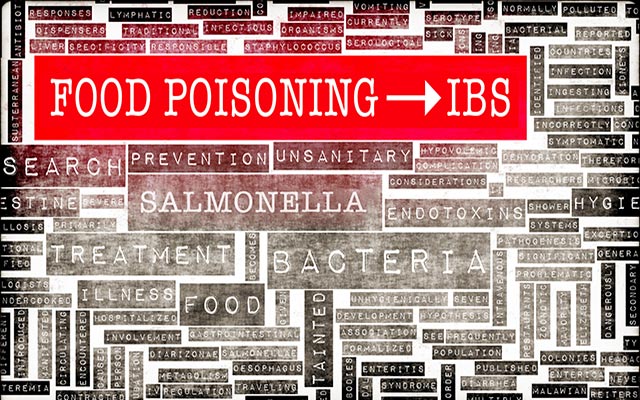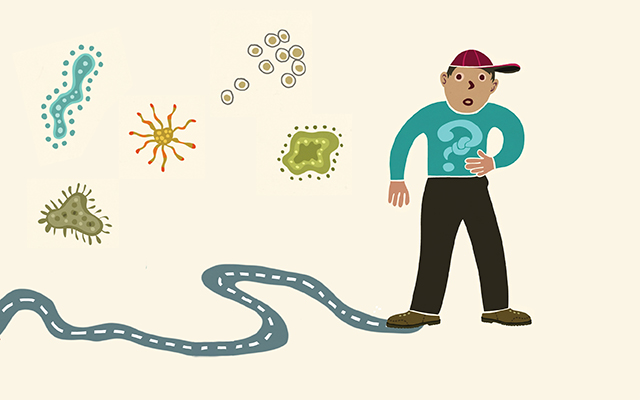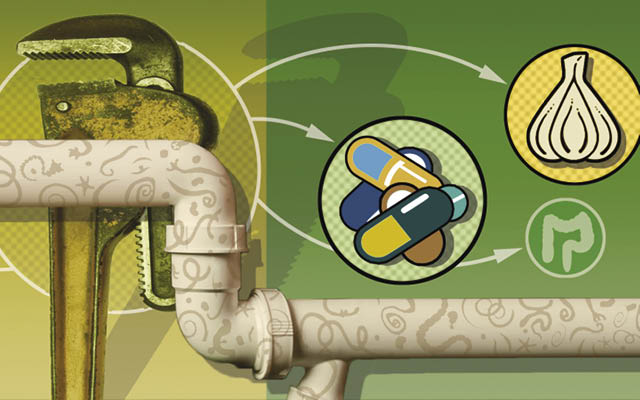Food poisoning is obviously no fun. “At first you feel like you’re going to die,” says a friend of mine about the gastrointestinal fallout of food poisoning. “As the symptoms rage on, you worry that you never will.”
In most cases, the acute symptoms of food poisoning pass within 24 hours and people can return to their regular lives (if not to the restaurant or meal that made them sick). But for roughly one in four food-poisoning sufferers, symptoms can linger — and linger and linger.
“A lot of people have food poisoning and they’re fine,” says Portland, Ore.–based naturopath Crane Holmes, ND, who specializes in treating complicated functional gastrointestinal disorders. “But about 25 percent of people who have food poisoning will develop IBS.”
A meta-analysis conducted by the Mayo Clinic found that food poisoning increases a person’s risk of developing IBS by four times.
IBS stands for irritable bowel syndrome, whose symptoms include abdominal pain, bloating, and a change in bowel habits — diarrhea or constipation or both. IBS is believed to be the most common gastrointestinal disorder in the world, affecting up to 15 percent of the U.S. population. “And we think about 60 to 70 percent of IBS is caused by food poisoning, especially IBS with diarrhea,” says Mark Pimentel, MD, head of the Pimentel Laboratory and executive director of the Medically Associated Science and Technology Program at Cedars-Sinai Medical Center in Los Angeles. IBS that develops after a bout of food poisoning is referred to as post-infectious IBS. (More on the distinction between IBS and post-infectious IBS below.)
It’s a bummer to know that food poisoning can leave a lasting mark on one’s GI tract. But this new understanding of food poisoning as one of the root causes of IBS is good news for IBS sufferers. As recently as the 1990s, IBS was thought to be a psychological condition — a more pathological version of the butterflies in the stomach that many people experience before, say, giving a big speech — and sufferers were left to believe that their stomach pain was all in their heads. This made access to effective treatment options, and to information on helpful food and lifestyle changes, virtually nonexistent. And the fact that IBS is more common among women than men added fuel to the dangerous misconception — one often tacitly endorsed by the medical establishment — that women are unreliable narrators of what is happening in their own bodies.
“Medical schools used to teach about IBS as a ‘disease of nervous and anxious women,’ and some medical professionals still practice as if this is true,” says Holmes. “It’s frustrating, as we have proven over the past 15 to 20 years that this claim is completely false.”
Now that IBS is established as a disease with organic physical origins, people with gastrointestinal pain are both more likely to be believed and more likely to get effective treatment for their symptoms.
Here’s how food poisoning can trigger IBS and what steps you can take if you suffered a bout of food poisoning and haven’t felt the same since.
How Food Poisoning Can Become a Chronic Illness
A lot of different bacteria can cause food poisoning (salmonella, E. coli, listeria, campylobacter, shigella, etc.), but these different bugs share a common characteristic: They all release a toxin called cytolethal distending toxin B (CdtB). CdtB is not something your body wants hanging around, so the immune system produces antibodies to destroy it. This is a good and important process for healing.
But for the people who go on to develop IBS, this process goes sideways. After a bout of food poisoning, the immune system produces a cascade of anti-CdtB antibodies, like it should, but the antibodies go on to attack more than just the CdtB. They also attack a normal, healthy protein in the body called vinculin, which helps control how quickly (or slowly) things move through the GI tract. This is an autoimmune response (where the body starts to attack itself) triggered by food poisoning.
Why does the body launch this unwanted autoimmune attack on vinculin? Because on a molecular level this protein looks very similar to CdtB. In other words, the immune system confuses vinculin (the good guy) with CdtB (the bad guy). And it’s that molecular mistake that causes chronic GI distress: The constant attack on vinculin, which helps regulate gut motility, can lead to a cascade of gut troubles. The very same process is at work in people who have thyroid issues and eat gluten: Gliadin, the protein in gluten, resembles an enzyme found in the thyroid gland and so both are targeted by the immune system.
“Vinculin helps keep the wires in the house connected, so to speak,” says Pimentel. When vinculin is under attack by the immune system, “the wires get disconnected and the gut no longer flows in a coordinated fashion.”
Specifically, the gut loses coordination in between meals, as opposed to when you eat. “The gut still flows well for food,” says Pimentel. “But it doesn’t flow when you’re not eating. It’s the ‘cleaning thing’ that happens in between meals that’s most affected.” The official name for the ‘cleaning thing’ is migrating motor complex, or MMC, and its job is to sweep out undigested material between meals.
“It’s like the Zamboni that cleans the ice rink at night,” says functional-medicine practitioner Jill Carnahan, MD. When that cleaning process doesn’t happen properly, food particles loiter in the small intestine longer than they should, leading to the buildup of bacteria and the development of IBS-type symptoms. (It can also lead to small intestinal bacterial overgrowth (SIBO) symptoms. More on that below.)
How to Deal With Post-Infectious IBS
Now that experts understand the food poisoning–IBS connection, they can give more targeted and effective advice on avoiding it altogether as well as easing symptoms. Here are some strategies that Pimentel and Holmes recommend:
Focus on prevention.
Food poisoning tends to strike indiscriminately, but there are steps you can take to decrease your chances of getting a bout of food poisoning or traveler’s diarrhea. If you feel food poisoning coming on, try using activated charcoal to absorb the toxins, suggests Holmes. He recommends four capsules every five hours, as needed, with plenty of water, not to exceed 20 capsules per day. The charcoal will bind with certain nutrients and drugs, not just toxins, so it is best taken apart from other medications or food by 30 to 60 minutes.
Take water-restriction advice seriously when traveling in countries with different bugs in the water, and don’t feel bad about avoiding fresh fruit and produce if it has been washed in water. Dietitian and health coach Carrie Dennett, MPH, RDN, describes a client she worked with who had vacationed in Central America. At one meal, everyone in her party was served lasagna and fresh salad. The client ate the lasagna and skipped the salad, noticing that the lettuce had recently been washed (though she felt bad for leaving the ‘healthy’ option on her plate.) Everyone else in the party got terrible traveler’s diarrhea, while Dennett’s client avoided illness.
And don’t forget that food poisoning can strike at home, too. Remember to wash all fresh produce, thoroughly cook meat and eggs, and follow other commonsense prevention advice in the kitchen.
Rule out other (serious) conditions.
Before taking steps to address IBS, it’s important to rule out a true GI pathology, says Pimentel. Conditions like ulcerative colitis, Crohn’s disease, and celiac disease present with some of the same symptoms as IBS and can cause significant harm if undiagnosed and untreated.
Rule in IBS.
With today’s understanding of post-infectious IBS as an organic physical condition — and not a strictly psychological one, as was previously thought — experts can test for the condition. Pimentel developed the first blood test for post-infectious IBS. (The blood test looks for anti-vinculin and anti-CdtB antibodies.)
But not all IBS is triggered by food poisoning. In those cases where a blood test is negative, then you have to resort to a process of exclusion (ruling out other conditions) and assessing risk factors. Holmes lists several key risk factors: a history of heavy antibiotic use, excessive alcohol intake, brain injuries/head trauma, thyroid conditions, chronic stress, and a history of abdominal surgeries or pelvic surgeries. “I like to use a bucket analogy,” says Holmes. “All these things pour into it — there’s a stress, maybe there’s an abdominal surgery, maybe there’s a thyroid issue. At a point, a person’s bucket gets too full and it overflows and the overflow is [GI] symptoms.” (The same risk factors are thought to predispose people who get food poisoning to go on to develop IBS.)
Know that SIBO is a type of IBS.
As many as 78 percent of people with IBS also have SIBO, or small intestinal bacterial overgrowth, says Holmes. “SIBO is that person’s IBS,” he adds. Breath testing can be used to help identify SIBO (though the test has limitations, including a high rate of false positives) and a positive test, along with risk factors and symptoms, can be used to help establish an IBS and/or SIBO diagnosis and point the way toward effective treatment.
Find a doctor who is literate in functional GI issues.
“One of the problems we have is that it takes about 10 years for [this type of research] to reach primary-care doctors,” says Pimentel. Hence, many doctors may simply not know about the food poisoning–IBS connection or the best way to move forward with IBS treatment. Even if you’re working with a doctor who is IBS-literate (or if you’ve worked with several), don’t be afraid to move on if you’re not making progress, says Holmes. “If you’re not making headway after a while, find someone who is even more comfortable with [functional GI issues].”
Try a low-FODMAP diet (but only temporarily).
A low-FODMAP diet can help with diarrhea-predominant IBS, but this way of eating “is only a short-term solution,” says Pimentel. “You can’t be on it long term without being malnourished.” Pimentel recommends a low-fermentation diet as a more sustainable, less restrictive approach to eating for IBS.
Try taking a motility agent.
A hallmark of IBS is slow motility, particularly during non-eating windows of time (when the MMC is supposed to sweep the intestines clean of lingering food particles but doesn’t do an efficient job). So it can help to use natural supplements to encourage the MMC to be a better housekeeper. Ginger has been shown to be especially helpful. Holmes recommends 1,000 mg of ginger before bed. (As with any new supplement, talk to a licensed healthcare provider before starting.)
Try visceral manipulation (but look for an experienced practitioner).
One of the risk factors that predisposes people to developing IBS is a history of abdominal or pelvic surgeries. That’s because scar tissue can form into hairpin turns in the intestines, trapping unwanted bacteria and leading to IBS-type and SIBO-type symptoms.
A targeted form of massage called visceral manipulation can soften scar tissue and help with symptoms, but only work with an experienced practitioner, advises Holmes. If a hairpin turn is suddenly released and toxins begin to flood the system, “people can actually get sicker,” he says.
Don’t take probiotics.
Since part of the problem with IBS (and SIBO) is too many toxins lingering in the small intestine, you don’t want to add more, says Pimentel, adding that two new clinical trials show that patients got worse when taking probiotics.
Understand your antibiotic choices.
One of the most commonly prescribed antibiotics for IBS and/or SIBO is rifaximin. Unlike broad-spectrum antibiotics like azithromycin (commonly known as a Z-Pak), rifaximin doesn’t flood the entire body, killing every bug (good and bad) in its path. Instead, it stays in the small intestine, says Holmes. “And it has lost most of its effect by the time it reaches the large intestine,” which is a good thing. The bugs that contribute to IBS and SIBO-type symptoms are stuck in the small intestine (where they shouldn’t be).
About two-thirds of people who take a two-week course of rifaximin relapse, says Pimentel. “But what we see is that if a person responds really well to rifaximin the first time and then relapses, they will respond well again and again.” So he suggests doing another course (or two) of rifaximin if you relapse. “Rifaximin doesn’t change the microbiome. Most of the bugs that were in the gut before the antibiotic are there afterward,” says Pimentel. “There is no apocalypse from rifaximin.”




This Post Has 0 Comments